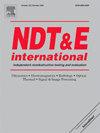缺陷处基本横波的模态转换
IF 4.5
2区 材料科学
Q1 MATERIALS SCIENCE, CHARACTERIZATION & TESTING
引用次数: 0
摘要
检测板上的缺陷是必不可少的,超声波引导波提供了检测缺陷的潜力,从焊缝气孔到较大的腐蚀斑块。电磁声换能器(emat)产生的剪切水平(SH)波先前已被证明与这两种类型的缺陷相互作用,其反射特性取决于缺陷的几何形状以及所选择的波长和波模。本文研究了当入射的SH0波与板上的缺陷相互作用时发生的模式转换反射的行为。反射模式转换的基对称兰姆波的性质取决于缺陷的宽度、长度和深度,它们决定了反射峰发生的角度。本文旨在发展对缺陷行为的基本理解,表明缺陷宽度反射行为遵循改进的单缝衍射行为,而缺陷长度依赖是由于从缺陷的正面和背面反射的波之间的干涉。本文主要采用有限元模拟,并进行了实验验证。S0反射很小,但结果可以与SH0反射分析相结合,从而提高检测小(mm尺寸)缺陷的概率。本文章由计算机程序翻译,如有差异,请以英文原文为准。
Mode conversion of the fundamental shear horizontal wave at a defect
It is essential to detect defects in plates, and ultrasonic guided waves offer the potential for detection of defects ranging from porosity in welds, through to larger corrosion patches. Shear-horizontal (SH) waves generated by electromagnetic acoustic transducers (EMATs) have previously been shown to interact with both types of defect, with the reflection properties dependent on the defect geometry and the wavelength and wavemode chosen. This paper investigates the behaviour of the mode converted reflections that occur when an incident SH0 wave interacts with a defect in a plate. The properties of the reflected mode converted fundamental symmetric Lamb wave, S0, are shown to depend on the defect width, length and depth, which determine the angle at which a peak reflection occurs. This paper aims to develop fundamental understanding of the behaviour, showing that the defect width reflection behaviour follows a modified single-slit-diffraction behaviour, while the defect length dependence is due to interference between waves reflected from the front and back faces of the defect. Finite element simulations are primarily used, and verified experimentally. The S0 reflection is small, but results could be combined with analysis of SH0 reflections, enabling a higher probability of detection for small (mm-sized) defects.
求助全文
通过发布文献求助,成功后即可免费获取论文全文。
去求助
来源期刊

Ndt & E International
工程技术-材料科学:表征与测试
CiteScore
7.20
自引率
9.50%
发文量
121
审稿时长
55 days
期刊介绍:
NDT&E international publishes peer-reviewed results of original research and development in all categories of the fields of nondestructive testing and evaluation including ultrasonics, electromagnetics, radiography, optical and thermal methods. In addition to traditional NDE topics, the emerging technology area of inspection of civil structures and materials is also emphasized. The journal publishes original papers on research and development of new inspection techniques and methods, as well as on novel and innovative applications of established methods. Papers on NDE sensors and their applications both for inspection and process control, as well as papers describing novel NDE systems for structural health monitoring and their performance in industrial settings are also considered. Other regular features include international news, new equipment and a calendar of forthcoming worldwide meetings. This journal is listed in Current Contents.
 求助内容:
求助内容: 应助结果提醒方式:
应助结果提醒方式:


